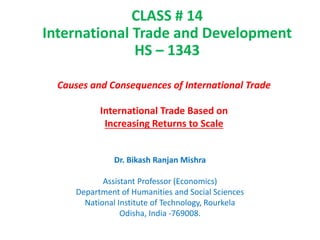
International trade and development Class 14 NTT (1).pptx
- 1. Causes and Consequences of International Trade International Trade Based on Increasing Returns to Scale Dr. Bikash Ranjan Mishra Assistant Professor (Economics) Department of Humanities and Social Sciences National Institute of Technology, Rourkela Odisha, India -769008. CLASS # 14 International Trade and Development HS – 1343
- 2. Conditions for NO Trade • Identical production functions among countries – Cost Advantage Theory (Absolute CAT and Comparative CAT) • Same relative endowments in all countries – Heckscher-Ohlin Model (H-O-M) • Constant Returns to scale – New Trade Theory (Paul Krugman) • Identical and homogeneous tastes in all countries – ? (Will explore gradually) • Absence of Trade distortions (taxes, subsidies, etc.) – Tariff and Non-tariff Trade barriers
- 3. Background of the Theory • One of the assumptions of the H–O model was that both commodities were produced under conditions of constant returns to scale in the two nations. • With increasing returns to scale, mutually beneficial trade can take place even when the two nations are identical in every respect. • This is a type of trade that the H–O model does not explain.
- 4. Increasing Returns to Scale • Increasing returns to scale refers to the production situation where output grows proportionately more than the increase in inputs or factors of production. – That is, if all inputs are doubled, output is more than doubled. If all inputs are tripled, output is more than tripled. • Increasing returns to scale may occur because at a larger scale of operation a greater division of labor and specialization becomes possible. – That is, each worker can specialize in performing a simple repetitive task with a resulting increase in productivity. • Furthermore, a larger scale of operation may permit the introduction of more specialized and productive machinery than would be feasible at a smaller scale of operation.
- 5. Description of the theory • The side figure shows how mutually beneficial trade can be based on increasing returns to scale. • If the two nations are assumed to be identical in every respect, we can use a single production frontier and a single indifference map to refer to both nations. • Increasing returns to scale result in production frontiers that are convex from the origin, or inward-bending. • With identical production frontiers and indifference maps, the no-trade equilibrium relative commodity prices in the two nations are also identical. • As we can see in the side Figure, this is PX/PY = PA in both nations and is given by the slope of the common tangent to the production frontier and indifference curve I at point A.
- 6. Description of the theory … • With trade, Nation 1 could specialize completely in the production of commodity X and produce at point B. • Nation 2 would then specialize completely in the production of commodity Y and produce at point B. • By then exchanging 60X for 60Y with each other, each nation would end up consuming at point E on indifference curve II , thus gaining 20X and 20Y. • These gains from trade arise from economies of scale in the production of only one commodity in each nation. • In the absence of trade, the two nations would not specialize in the production of only one commodity because each nation wants to consume both commodities.
- 7. Description of the theory … • Note that the no-trade equilibrium point A is unstable in the sense that if, for whatever reason, Nation 1 moves to the right of point A along its production frontier, the relative price of X (the slope of the production frontier) will fall and will continue to fall until Nation 1 becomes completely specialized in the production of commodity X. • Similarly, if Nation 2 moves to the left of point A along its production frontier, PX/PY will rise (so that its inverse, Py/Px, falls) until Nation 2 becomes completely specialized in the production of commodity Y.
- 8. Concluding Observation • Several additional aspects must be clarified. • First of all, it is a matter of complete indifference which of the two nations specializes in the production of commodity X or commodity Y. In the real world, this may result from historical accident. • Second, it should be clear, at least intuitively, that the two nations need not be identical in every respect for mutually beneficial trade to result from increasing returns to scale. • Third, if economies of scale persist over a sufficiently long range of outputs, one or a few firms in the nation will capture the entire market for a given product, leading to monopoly (a single producer of a commodity for which there is no close substitute) or oligopoly (a few producers of a homogeneous or differentiated product). • Fourth, since the early 1980s, there has been a sharp increase in international trade in parts and components through outsourcing and offshoring, and these are the source of new and significant international economies of scale. – Outsourcing refers to the purchase by a firm of parts and components abroad in order to keep its costs down. – Offshoring refers, instead, to a firm producing in its own plants abroad some of the parts and components that it uses in its products. – While outsourcing and offshoring lead to international economies of scale, they also lead to complaints that a significant number of high-paying jobs are transferred abroad.
- 9. … End of Class 14 …
Editor's Notes
- * Represents class number 8 is suspended